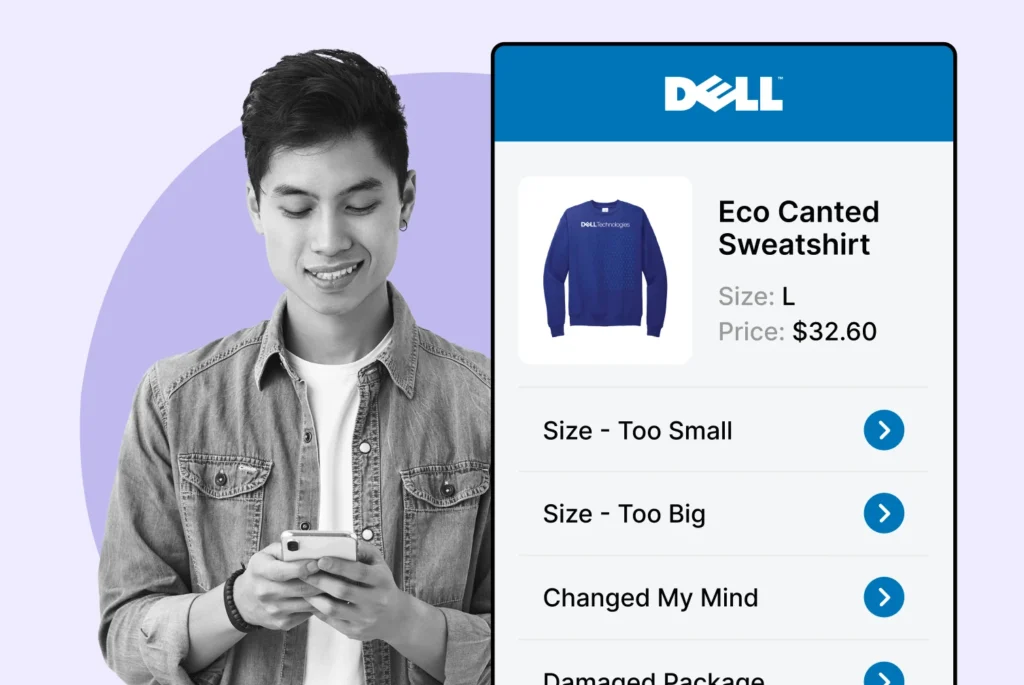
Top 7 Returns Management Mistakes: Avoid Costly Errors
Increase customer satisfaction and profit margins! Actionable steps to manage returns smartly: minimize costs, recover revenue.
Shipping, Tracking & Notifications
Boost customer experience and reduce support tickets
Realtime order and shipment tracking
Proactive order and shipping notifications
AI-Enhanced Discounted Labels
Predictive pre-purchase estimated delivery dates
Self-Serivce branded order tracking
Effortless experience delivered
Identify and Resolve Order Issues
Realtime order and shipment tracking
Make returns profitable and delight customers
Flexibility to define any return destinations & conditions
Simplify returns for your customers and team
Incentivize exchanges over returns
Returns management made easy for your team
Returns management made easy for your team
Easy claims and smart upsells
Understand why your customers are returning
In-Store & Curbside Pickup
Unify the online and the in-store experience
Hassle-free pickup experience for customers
In-Store dashboard to keep operations streamlined
In-Store and Online orders unified
Drive foot-traffic to your stores
Shipping, Tracking & Notifications
Boost customer experience and reduce support tickets
Realtime order and shipment tracking
Proactive order and shipping notifications
AI-Enhanced Discounted Labels
Predictive pre-purchase estimated delivery dates
Self-Serivce branded order tracking
Effortless experience delivered
Identify and Resolve Order Issues
Realtime order and shipment tracking
Make returns profitable and delight customers
Flexibility to define any return destinations & conditions
Simplify returns for your customers and team
Incentivize exchanges over returns
Returns management made easy for your team
Returns management made easy for your team
Understand why your customers are returning
In-Store & Curbside Pickup
Unify the online and the in-store experience
Hassle-free pickup experience for customers
In-Store Dashboard to keep operations streamlined
In-Store and Online orders unified
Drive foot-traffic to your stores
Boost customer experience and reduce support tickets
Realtime order and shipment tracking
Proactive order and shipping notifications
AI-Enhanced Discounted Labels
Predictive pre-purchase estimated delivery dates
Self-Serivce branded order tracking
Effortless experience delivered
Make returns profitable and delight customers
Flexibility to define any return destinations & conditions
Simplify returns for your customers and team
Incentivize exchanges over returns
Returns management made easy for your team
Equip your team for precise return checks.
Easy claims and smart upsells
Understand why your customers are returning
Unify the online and the in-store experience
Hassle-free pickup experience for customers
In-Store Dashboard to keep operations streamlined
In-Store and Online orders unified
Drive foot-traffic to your stores
Find the answer to all your questions
Take a step by step trip through our functionality to see how we can improve your ecommerce processes.
Explore the most comon questions about WeSupply
Calculate the ROI that WeSupply can bring you
Read actionable articles on how to optimize your post-purchase experience and decrease support tickets
Get inspired by stories of how our customers implemented an effortless post-purchase experience
Wondering if WeSupply is a good fit for you? Read through our use cases to see how we can help you increase conversion & improve CX!
A Deep Dive into Top Companies' Order Tracking & Returns Strategy
Find the answer to all your questions
Explore the most comon questions about WeSupply
Calculate the ROI that WeSupply can bring you
Request a no strings attached review of your current shopping experience and missed conversion opportunities
Take a step by step trip through our functionality to see how we can improve your ecommerce processes.
Read actionable articles on how to optimize your post-purchase experience and decrease support tickets
Get inspired by stories of how our customers implemented an effortless post-purchase experience
A Deep Dive into Top Companies' Order Tracking & Returns Strategy
Wondering if WeSupply is a good fit for you? Read through our use cases to see how we can help you increase conversion & improve CX!

Efficient return management is a cornerstone for D2C brand loyalty and growth. If return issues have been a bottleneck for your customer satisfaction or a drain on your profits, our returns management guide for D2C brands is tailored for you. This guide cuts through the complexity to give you actionable insights into perfecting your return workflows and bolstering customer trust, without getting lost in theory or fluff.
Efficient returns management is essential for D2C brands, impacting customer satisfaction, operational efficiency, and business growth, with 43% of Indian consumers likely to shop more online if returns were easier.
Managing returns presents challenges such as high return rates affecting profitability, complexities in processing, and maintaining customer trust, which can be mitigated by extending return periods and using automated systems.
Ecommerce returns management software provides benefits such as cutting down customer service calls, offering real-time tracking, and generating data-driven insights for continuous improvement of returns processes.
WeSupply optimizes returns management for D2C brands, boosting ROI and profitability. Tailor return windows, allow post-window exchanges, and use analytics to reduce returns and improve products. Automated management saves time, and a self-service process with proactive notifications enhances customer experience. Clear policies, fraud prevention, and a branded portal foster loyalty and trust. Integrate with third-party tools, and use features like post-purchase notifications, QR code labels, and personalized recommendations to drive satisfaction. Get started with WeSupply for efficient and profitable returns management.
Managing ecommerce returns can be a complex task, but when handled effectively, it can lead to increased customer satisfaction, improved operational efficiency, and business growth. The ability to manage returns efficiently is a key factor in the ecommerce returns management process and a cornerstone for D2C brands aiming to retain their customer base.
Returns management plays an integral role in the operations and growth of D2C brands. The impact of returns management is multi-faceted, influencing aspects such as customer satisfaction, operational costs, and overall business growth.
Now, let’s delve into these areas in more detail.
Effective returns management systems can enhance customer satisfaction and customer loyalty, translating into repeat purchases and positive referrals. A hassle-free returns process, in particular, can boost customer satisfaction and loyalty by a substantial margin.
Moreover, clear and favorable return policies can significantly influence buying decisions, with the majority of online shoppers reviewing return policies before making purchases. In fact, around 43% of Indian consumers indicate they would be more inclined to shop online if the returns process were simplified.
Returns management in D2C brands involves significant operational costs at various touchpoints, including employee handling and warehouse storage. However, automating the returns process can lead to reduced costs in manual processing, thus increasing profitability.
By integrating a customizable returns management system tailored to a business’s specific needs, the return process can be optimized and associated costs reduced. This is particularly true for larger D2C brands, where an efficient Return Management System (RMS) can contribute to cost savings by reducing labor costs and streamlining the return process.
Returns management is closely linked to customer satisfaction, retention, engagement, and consequently, revenue growth. By optimizing the returns management process, D2C brands can reduce return rates, streamline operations, and increase customer lifetime value.
Providing a customer-friendly returns process can contribute to a significant increase in sales for e-commerce businesses. This underlines the impact of returns management on revenue growth and shows how it plays a critical role in the financial health of a D2C brand.
While returns management can greatly impact a D2C brand’s success, it does come with its share of challenges. These challenges range from high return rates to the complexity of processing returns efficiently and managing customer expectations.
Let’s take a closer look at each of these challenges.
High return rates pose a significant challenge to profitability for D2C brands. In fact, some brands experience return rates up to 30% of sales, which can significantly reduce profits. This is especially true in certain sectors like online fashion, where return rates can be over 20% higher than brick-and-mortar stores due to the lack of tactile experiences and the inability for customers to try on items before purchasing.
However, strategies such as:
extending the return period to at least 30 days
providing clear and detailed product descriptions
offering virtual try-on or sizing tools
providing excellent customer service and support
can lead to a significant reduction in the return rate, alleviating the pressure on customers to make quick decisions and, in turn, reducing the pressure on the business’s profitability.
WeSupply can significantly boost your ROI and enhance profitability by optimizing the return process and providing actionable insights. By tailoring return windows to specific brands, you can maintain control while offering the flexibility that customers appreciate. Allowing exchanges even after the return window has expired fosters customer loyalty, encouraging repeat business. Detailed returns analytics empower you to understand return patterns, identify frequent returners, and make informed decisions to reduce return rates and improve product offerings.
Key Features:
Allow Exchanges After Return Window Expires: Enhance customer loyalty by offering post-window exchanges.
Returns Analytics for eCommerce Business:
Identify the most returned products.
Understand why products are returned.
Spot serial returners.
Reduce return rate with actionable insights.
Access returns data in BigQuery.
Discover how much you can save and boost your profitability with WeSupply—try our ROI Calculator today!
Processing returns efficiently can be quite complex. D2C brands face challenges in managing return policies, customer-facing return centers, and reverse logistics. However, with the help of software solutions and automated systems, these complexities can be managed more effectively.
For instance, automated SMS systems can streamline the return process for D2C brands by providing real-time updates and reducing the need for manual intervention. This not only simplifies the process but also reduces operational costs, increasing overall efficiency.
WeSupply simplifies the complexity of processing returns efficiently, saving time and reducing errors for your team. By automating the returns process, WeSupply helps you save up to 80% of the time typically spent on managing returns. This streamlined approach reduces fraud and human error while integrating seamlessly with your existing workflows, ERP, or 3PL systems. Additionally, a self-service returns process empowers customers with control and convenience, enhancing their overall experience.
Key Features:
Automate your return process.
Streamline the returns process.
Reduce returns fraud.
Reduce human error.
Collect images and feedback.
Integrate with your existing return workflow, ERP, or 3PL.
Returns Tracking: Enable customers to track their returns status easily and conveniently.
Keep customers informed with post-purchase email and SMS notifications.
Provide personalized offers to encourage repeat purchases.
Eliminate the need for “check-up” phone calls with proactive communication.
Managing customer expectations and maintaining trust are also crucial aspects in the returns process. An effective returns management process is vital for maintaining customer relationships, as it directly influences the customer’s experience.
Timely and accurate refunds, for instance, are significant factors in maintaining customer satisfaction and trust during the returns process. By addressing such aspects, brands can better manage customer expectations and foster a trustworthy relationship.
WeSupply helps manage customer expectations and maintain trust by providing clear, confusion-free return processes and proactive communication. By eliminating ambiguity around return windows and non-returnable items, WeSupply ensures customers are well-informed and confident in their return decisions. The reduction in customer inquiries, combined with a branded returns portal and instant credit options, creates a seamless and loyal customer experience.
Key Features:
Reduce Customer Inquiries: 24/7 support with clear return instructions, proactive status updates, and return label guidance.
Return Status Notifications
Return Delivery Confirmation
Return Instructions
Refund Confirmation
Build trust and exceed customer expectations with WeSupply’s efficient return management solutions. Book a Demo today!
Now that we’ve explored the role and challenges of returns management, let’s delve into the key concepts and components that make up an effective returns management process.
A well-articulated returns policy is essential in returns management. Such a policy sets expectations for customers and outlines the specific terms under which products can be returned, affecting both customer satisfaction and company operations.
In fact, a robust returns policy can reduce instances of ‘wardrobing’, which occurs when customers buy products with the intention of returning them after use. Furthermore, an extended return period of at least 30 days can lead to a significant reduction in the return rate.
WeSupply’s Pre-built Return Policies assist in setting clear and comprehensive return rules, ensuring customers understand the return process from the start. These policies are designed to be straightforward and easy to implement, reducing confusion and minimizing disputes. By providing well-defined guidelines, WeSupply helps create a seamless and consistent experience for both customers and your team, fostering trust and enhancing satisfaction.
An example of a pre-built return policy designed specifically to prevent fraud:
Create custom return policies
There are many moving pieces in ecommerce logistics. Book a quick call with our experts to see how WeSupply can help you take control by creating custom policies to handle them all easily. You get to decide how you want to handle final sale items, return window lengths, return request approvals, and more.
A return center serves as a dedicated facility to manage the returning items from customers, allowing for streamlined and specialized handling of returns that differ from outbound fulfillment processes.
Furthermore, a customer-facing returns center can enhance the customer experience by providing transparency and efficiency. This includes:
Self-service options that allow customers to independently initiate returns or exchanges
Reducing the workload on customer service agents
Providing a more seamless returns experience
WeSupply’s Branded Returns Portal provides a customer-facing portal that ensures seamless returns, enhancing customer loyalty and satisfaction. Instead of redirecting customers to confusing third-party courier pages, WeSupply offers a fully branded, omnichannel experience. The portal features customizable tracking pages, email, and SMS notifications, allowing you to match your brand’s logo, colors, and styling without any coding required. Intelligent return rules streamline the post-purchase experience, making returns effortless for your customers and reinforcing their trust in your brand.
Gathering and analyzing returns data is another crucial component of returns management. This process can help companies understand patterns, reasons, and trends associated with returned products.
For instance, insights derived from returns data can be used to make product and service improvements, thereby reducing future returns and maintaining customer trust. Companies can also enhance inventory management by adjusting stock levels based on return patterns to reduce overstocking or stockouts.
WeSupply’s Returns Data Analytics empower eCommerce businesses to gather valuable insights for continuous improvement. By understanding why customers are returning products, identifying the most frequently returned items, and recognizing serial returners, you can make informed decisions to reduce return rates. Actionable insights derived from comprehensive returns data, available in BigQuery, help optimize product offerings and enhance customer satisfaction.
Reverse logistics refers to the process of managing the return of products from customers back to the warehouse. This process can be significantly more challenging than outbound logistics due to the need for inspecting, processing, and properly reintegrating returned items into the supply chain.
However, efficient reverse logistics can significantly reduce costs by quickly processing returns and reintroducing sellable items into inventory. Furthermore, strategic improvements in reverse logistics can lead to benefits such as reduced costs, faster service, enhanced customer satisfaction, customer retention, and improved brand sentiment.
WeSupply enhances reverse logistics by efficiently managing returns from customer to warehouse. It streamlines the process, calculates restocking fees, applies vendor-specific policies, and prevents return fraud. Quality control is ensured through detailed inspections and feedback collection. An activity log improves communication and efficiency, enabling quick resolution of returns.
Calculate restocking fees.
Apply vendor policies.
Prevent return fraud.
Ensure quality control.
Collect images and feedback.
Restock during returns process.
Enable team collaboration.
Track return actions.
Centralize return information.
With WeSupply, streamline your reverse logistics for a more efficient, transparent, and customer-friendly return management process. Experience the benefits of reduced fraud, improved inventory control, and enhanced communication across your team, all contributing to a smoother and more profitable operation.
Product disposition involves the classification of returned products based on their condition, such as ‘New w/ Tags,’ ‘Dirty,’ or ‘Damaged’. This grading process is essential for maximizing recovery value.
Moreover, for certain categories like fashion, a quick turnaround of returns to resale is essential due to items becoming outdated swiftly. Thus, the grading process can help minimize handling time and maximize recovery value.
WeSupply optimizes product disposition by grading products to maximize value recovery. With defined quality check criteria, each returned product is carefully inspected to determine its resale potential. The system collects images and feedback from customers, ensuring comprehensive evaluations. Warehouse staff can leave detailed notes on each inspection, enhancing quality control and facilitating informed decisions on product disposition.
The returns management process is a detailed workflow that involves several steps, from the customer initiating a return to the product’s disposition.
Let’s delve into the specifics of this process.
The ecommerce returns management process includes the following steps:
Customer initiates the return after delivery, usually through an easy return initiation process.
The business arranges for the pickup of the returned product.
The returned items are inspected to verify their condition and compliance with the return policy.
Clear and consistent communication is maintained with the customer throughout the return process, including updates on receipt, inspection results, and the status of the refund or exchange.
These steps help fortify trust and ensure a smooth returns process for both the customer and the business, while also providing the option of store credit.
However, an inefficient returns process can result in:
customer frustration
increased costs
damage to brand reputation
inventory management challenges
lost sales opportunities
Therefore, it’s vital to streamline the returns process as much as possible.
The workflows for online and in-store returns can differ significantly. For online returns, businesses must tackle challenges such as:
the logistical complexities of reverse shipping, especially for large or geographically widespread returns
ensuring the return process is user-friendly and convenient for customers
managing inventory and restocking returned items
However, advances in technology and automation have made it possible to simplify and streamline online returns. For instance, self-service returns simplify reverse logistics by allowing customers to direct the process, reducing the burden on customer support teams, especially during high-volume periods like holidays.
Efficient reverse logistics are vital for:
Managing expenses
Coordinating the reverse flow of goods
Minimizing the time goods spend in the reverse chain, thereby reducing their depreciation in value.
Improvements in reverse logistics can lead to the following benefits:
Reduced costs
Faster service
Enhanced customer satisfaction
Customer retention
Improved brand sentiment
It’s also important to remember that data gathered during the reverse logistics process can provide insights for product improvements and reducing future returns.
Implementing technology solutions, such as ecommerce returns management software, can greatly enhance the efficiency and effectiveness of the returns management process. Let’s delve into the benefits of such software, key features to look for, and how to choose the right software for your business.
Ecommerce returns management software can significantly cut down on customer service calls by providing a self-service portal for customers to initiate returns and track support tickets. Implementing an ecommerce returns management system not only simplifies the process but also reduces operational costs, increasing overall efficiency. With the help of returns management services, businesses can further streamline their return processes and enhance customer satisfaction.
Furthermore, such software offers valuable data-driven insights by allowing sales and support teams to monitor real-time return rates and reasons for returns. This can help pinpoint issues such as product defects or shipping damage, leading to more informed business decisions.
Key features of returns management software include return authorization, return transportation coordination, inspection and evaluation of items, and automated refund and reimbursement processes.
Other important features to consider are:
Real-time tracking
Inventory management
Communication with customers
Reporting
These features not only streamline the returns process but also provide valuable insights into customer behavior and return trends.
When choosing returns management software, it’s important to consider factors like:
the volume of returns
ecommerce platform compatibility
geographic reach
the specific problems the software addresses.
Furthermore, when choosing software for your ecommerce business, consider the following:
Choose software that integrates well with your existing ecommerce platform
Look for software that offers branded returns experiences
This can be beneficial for D2C brands aiming to maintain brand consistency.
WeSupply helps implement technology solutions for returns management, enhancing efficiency and customer satisfaction. By leveraging high open-rate post-purchase email and SMS notifications, WeSupply keeps customers informed about their return status and offers personalized deals. The system supports returns tracking, autogenerated QR code return labels, and a self-service returns process, providing a seamless experience. Flexible return rules and a branded returns portal further boost customer loyalty. Integration with various third-party tools ensures a smooth and cost-effective implementation.
QR Code Return Labels: Simplified, hassle-free returns.
Self-Service Returns: Frictionless returns experience.
Branded Returns Portal: Omnichannel, branded return experience.
Integrations: Connect with hundreds of third-party tools.
Enhance your returns management process and boost customer satisfaction with WeSupply’s advanced technology solutions. Streamline operations, improve efficiency, and deliver a seamless, branded experience for your customers today. Book a Demo!
Traditional return processes often lead to a significant loss in sales and missed opportunities for further engagement with customers. Many businesses struggle to convert these returns into exchanges, which can negatively impact revenue and customer satisfaction. WeSupply offers a comprehensive solution to transform returns into exchanges, retaining sales and enhancing customer loyalty.
Key Features:
Exchange return items with any product
Reship the same item
Exchange for a same-value item
Exchange for a higher-value item
Boost average order value with instant store credit
Reward customers choosing store credit over refunds
Redirect customers to the product catalog post-return
Automatic refunds as store credits
Automatic issuance of coupon codes
Automatic issuance of gift cards
Encourage repeat purchases with store credits
By leveraging WeSupply’s solutions, businesses can efficiently manage returns, incentivize exchanges, and ultimately increase sales and customer satisfaction.
Analyzing returns data is an integral part of returns management. This process involves monitoring key performance indicators (KPIs) and leveraging customer feedback for continuous improvement.
Let’s delve into these aspects in more detail.
Monitoring KPIs such as the Rate of Purchase Return provides insights into business aspects such as customer satisfaction, product quality, and the effectiveness of sales and marketing strategies. A high Rate of Purchase Return suggests decreased customer satisfaction and potentially signals a need for improvements in product quality, customer service, or sales strategies. However, strategies such as extending the return period to at least 30 days can lead to a significant reduction in the return rate, alleviating the pressure on customers to make quick decisions and, in turn, reducing the pressure on the business’s profitability.
Other important KPIs to consider include:
Customer Acquisition Cost
Average Order Value
Repeat Purchase Rate
Shopping Cart Abandonment Rate
Customer Lifetime Value
Monitoring these KPIs can provide valuable insights into customer behavior, return trends, and overall business performance.
WeSupply’s Returns Analytics enables businesses to analyze returns data for continuous improvement, ultimately boosting profit margins. By identifying the most exchanged products and collecting customer feedback, businesses can refine their processes, products, and return policies. Detailed insights into the financial impact of returns, including revenue lost and cost of returns, help in understanding and reducing return rates. Additionally, analyzing returns by region and reasons for returns provides valuable information to enhance customer lifetime value and satisfaction.
Identify Most Exchanged Products: Pinpoint items frequently returned.
Collect Product Feedback: Gather insights directly from customers.
Financial Impact Analysis: Understand revenue lost and cost of returns.
Regional Return Analysis: Examine returns by region and reasons.
Customer Lifetime Value: Enhance strategies to increase customer satisfaction and retention.
Customer feedback is a valuable resource for product improvement. Companies can improve product quality and customer satisfaction by acting on customer feedback and returns data to identify and prioritize areas in need of enhancement.
For instance, incorporating customer feedback into the research and development process can eliminate guesswork and validate assumptions. Also, feedback enables companies to innovate by exploring new ideas on how to enhance their products.
WeSupply’s Post Purchase Analytics empowers businesses to leverage customer feedback for continuous product improvement. By tracking key metrics like Customer Satisfaction (CSAT) and Net Promoter Score (NPS), you gain valuable insights into your post-purchase experience. Understanding what delights your loyal customers and identifying areas for improvement allows for constant fine-tuning and adaptation. This data-driven approach ensures you can address any issues, be it order fulfillment processing times, product quality, or other factors, ultimately enhancing customer satisfaction and loyalty.
While returns are inevitable in any business, there are strategies that D2C brands can implement to minimize their occurrence. These include providing accurate product descriptions and visuals and offering personalized recommendations.
Detailed product presentations, including high-quality images and comprehensive customer reviews, can bolster online shopping experiences and decrease return rates.
For items like clothing, where sizing is important, providing detailed size charts, measurements, and fit guidance can help customers choose the right size and diminish returns due to sizing issues. Implementing strict quality control processes to ensure that products are inspected for defects and damages before shipping can also decrease returns resulting from quality issues.
WeSupply’s Returns Analytics enhances your product offerings by providing detailed SKU-level insights into return reasons, such as color, quality, and size issues. This data allows you to refine your product descriptions and visuals accurately. By adjusting sizing charts based on specific product feedback, reviewing and updating product images, identifying items that need more reviews, and gathering customer feedback on product fit, you can ensure your product information is precise and customer-centric, reducing returns and increasing satisfaction.
Offering personalized recommendations can also aid in reducing returns. Utilizing customer data like purchase history, browsing behavior, and user-specific data such as age, location, and device usage can aid in crafting personalized recommendations for customers.
Moreover, including user-generated content such as customer reviews and experiences can aid in providing more personalized and realistic expectations of products, thus potentially reducing returns.
WeSupply enhances customer experience by offering personalized recommendations that guide customer choices. Utilizing high open-rate post-purchase email and SMS notifications, WeSupply keeps customers informed with proactive return updates and personalized deals. Integration with Justuno allows for smart product recommendations based on customer purchase history and behavior, boosting sales and engagement.
Keep customers informed with return notifications.
Provide personalized offers via email and SMS.
WeSupply x Justuno Integration:
Use powerful user segmentation with specific filters and algorithms.
Upsell higher-priced products to increase average order value.
Cross-sell relevant items for each product category.
Highlight most purchased or viewed products to drive additional revenue.
Enhance customer satisfaction and drive sales with WeSupply’s personalized recommendation features.
Evereve faced significant challenges in managing their fashion industry orders and returns, with manual processes leading to inefficiencies and lack of visibility into return reasons. This caused issues such as data limitations, slow return processing, lack of accountability, and an overwhelmed customer service team. The goal was to streamline returns, enhance customer experience, and boost sales and loyalty.
By integrating WeSupply’s technology, Evereve transformed their returns process. Automation and a unified interface improved operational understanding and introduced a self-service returns culture. Key objectives included proactivity, self-service, and return flexibility. This led to cost savings, faster and more accurate returns, and a streamlined customer experience, ultimately increasing customer satisfaction and loyalty.
Read the full case study to see how Evereve turned returns into opportunities with WeSupply.
Combat inconvenience with proactivity & self service
Book a quick call with our experts to see how WeSupply can help you make returns easy for your customers with a beautiful, self-service solution that makes their experience easier while also providing new ways to lower costs and earn back revenue.
In conclusion, while managing returns may present challenges, it also provides opportunities for growth. By embracing these challenges and continuously improving processes, D2C brands can transform returns management into a lever for business growth.
In summary, effective returns management is crucial for D2C brands. From understanding the role of returns management to identifying key challenges, implementing technology solutions, and leveraging data for continuous improvement, there’s much to consider. However, by embracing these challenges and optimizing processes, D2C brands can transform returns management from a pain point into a lever for growth.
WeSupply offers the ultimate returns management guide for D2C brands by optimizing the return process and providing actionable insights to boost ROI and profitability. Tailoring return windows for specific brands, allowing exchanges after the return window, and comprehensive returns analytics help businesses understand return patterns and improve product offerings. Automated returns management saves time and reduces errors, while a self-service returns process and proactive notifications enhance the customer experience. Clear return policies, fraud prevention measures, and a branded returns portal foster customer loyalty and trust. Pre-built return policies and efficient reverse logistics ensure seamless return management. The platform supports technology solutions like high open-rate post-purchase notifications, QR code return labels, and Justuno integration for personalized recommendations, driving customer satisfaction and engagement. Get started today and transform your return processes for a more efficient and profitable operation.
Returns management is crucial for D2C brands as it affects customer satisfaction, operational costs, and business growth.
The main challenges faced by D2C brands in managing returns include high return rates, the complexity of processing returns efficiently, and managing customer expectations.
The key components of returns management include the returns policy, return center, returns data, reverse logistics, product disposition, and return optimization. These elements are essential for an effective returns process.
Implementing ecommerce returns management software can streamline the returns process, offer real-time visibility, and provide valuable data-driven insights, ultimately enhancing returns management.
To minimize returns in D2C brands, it’s best to provide accurate product descriptions and visuals, as well as offering personalized recommendations.
WeSupply is a comprehensive returns management solution designed to optimize the return process, boost ROI, and enhance profitability for D2C brands. It offers tailored return windows, post-window exchanges, and detailed returns analytics to reduce return rates and improve product offerings.
WeSupply allows you to customize return policies to fit specific brands, balancing flexibility and control. This helps maintain clear and brand-specific return processes that cater to different customer expectations.
WeSupply’s returns analytics provide insights into the most returned products, reasons for returns, and identification of serial returners. This data helps you understand return patterns, reduce return rates, and improve product offerings by using SKU-level analytics.
Yes, WeSupply does have an official Shopify App. You can download and begin to integrate it with your Shopify store.
Yes, WeSupply has an official extension for Magento. The WeSupply x Magento integration allows for automating order tracking experiences, reducing customer inquiries, automating shipping email and SMS notifications, and providing a fully branded order tracking experience
Yes, WeSupply has an official BigCommerce App. You can integrate WeSupply with your BigCommerce store to improve your post-purchase customer experience.
Learn How To Create Successful Post Purchase Email Campaigns
Build an effective post-purchase email flow that helps you increase customer satisfaction and drive revenue growth!

Increase customer satisfaction and profit margins! Actionable steps to manage returns smartly: minimize costs, recover revenue.

In this guide, we dive into optimizing these solutions, with a focus on how Shopify storefronts can particularly benefit.

How to turn the returns process from a cost center into a strategic advantage, all while keeping your customers happy and loyal!

How can your business reduce costs while keeping customers satisfied: Focused insights into optimizing your returns process!

Increase customer satisfaction and profit margins! Actionable steps to manage returns smartly: minimize costs, recover revenue.

The why and how of post purchase emails: tips for crafting emails that engage, build loyalty, and drive sales without overwhelming customers.

Enhance your business efficiency and turn a potential loss into a growth catalyst without any fluff – just direct, actionable insights.

Streamline returns & transform potential losses into growth opportunities: best practices, insightful data analytics, innovative software.

Uncover actionable steps for creating a seamless returns process that upholds customer trust and streamlines operations!